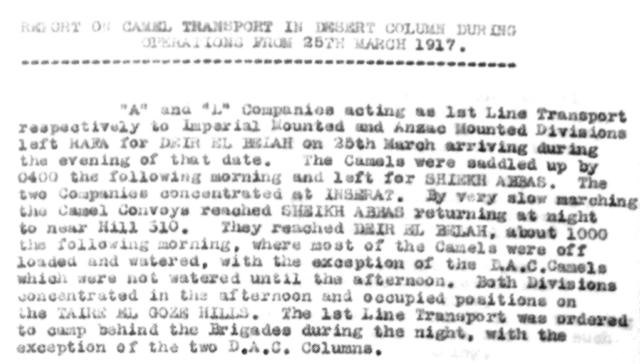Topic: AIF - DMC - British
The First Battle of Gaza
Palestine, 26 to 27 March 1917
Egyptian Expeditionary Force Camel Transport Corps Report on Operations

Camel Transport Corps Report on Operations.
The following is a transcription of the Report on Operations from the Camel Transport Corps detailing their role during the First Battle of Gaza, Palestine, 26 to 27 March 1917.
Report on Camel Transport in Desert Column during operations from 25th March 1917.
"A" and "L" Companies acting as 1st Line Transport respectively to Imperial Mounted and Anzac Mounted Divisions left Rafa for Deir el Belah on 25th March arriving during the evening of that date. The Camels were saddled up by 0400 the following morning and left for Sheikh Abbas. The two companies concentrated at In Seirat. By very slow marching the camel Convoys reached Sheikh Abbas returning at night to near Hill 310. They reached Deir el Belah, about 1000 the following morning, where most of the Camels were off loaded and watered, with this exception of the Divisional Armoured Column Camels which were not watered until the afternoon. Both Divisions concentrated in the afternoon and occupied positions on Taire el Goz Hills. The 1st Line Transport was ordered to camp behind the Brigades during the night, with the exception of the two Divisional Ammunition Columns.
On the evening of the day (27th March) it was decided to change the 1st Line for Horse Transport and as many Camels as could be spared were sent in during the night. The Ammunition of the Divisional Ammunition Column Camel Columns was also transferred during the night to waggons in case an action occurred the following morning.
The following day most of the Camels of the 1st. Line were sent in and the Companies were formed into convoys.
The Camels during the period 0400, 26th March to 1000, 27th March were kept loaded owing to Military Operations and this particularly hard on the Camels of the Divisional Ammunition Column which were carrying heavy loads of ammunition. As result 77 camels "L" Company and 58 camels of "A" Company were sent to the Depot Section with sore beaks and pressure swellings on the ribs. Considering the long period during which the loads were carried, the number of casualties was small and many of the camels will be fit for work within a month.
As 48 hours Grain was carried in sand bags on each camel, it was possible to feed the camels without much difficulty and without having recourse to the Emergency Forage Rations.
A Special emergency ration of Biscuit 12 ounces, Dates or Onions 8 ounces was carried for Drivers, who were on a reduced scale as were the remainder of the troops. In some cases a misunderstanding occurred to the issue of these rations, but the majority of the drivers received the Ration. The value of carrying Camel rations in sand bags on each camel cannot be over estimated, as by this means any detached group of camels can be fed as opportunity offers.
The drivers at present have no means of carrying rations and a Haversack or something of a similar nature appears necessary, as drivers are sometimes detached from the main Convoy carrying their rations. Neither Camels nor men come under shell fire but two camels with Anzac Signals Equipment were abandoned during the withdrawal of the Mounted troops.
Signed M Moberly, Major.
Deputy Inspector, Camel Transport Corps
Desert Column
14 April 1917
War Diaries
All War Diaries cited on this site should be read in conjunction with the Australian Light Horse Studies Centre, AIF War Diaries of the Great War, Site Transcription Policy which may be accessed at:
Australian Light Horse Studies Centre, AIF War Diaries of the Great War, Site Transcription Policy
Further Reading:
British Forces, EEF, Roll of Honour
The First Battle of Gaza, Palestine, 26 to 27 March 1917
The First Battle of Gaza, Palestine, 26 to 27 March 1917, Allied Forces, Roll of Honour
The Palestine Campaign, 1917 - 1918
Battles where Australians fought, 1899-1920



